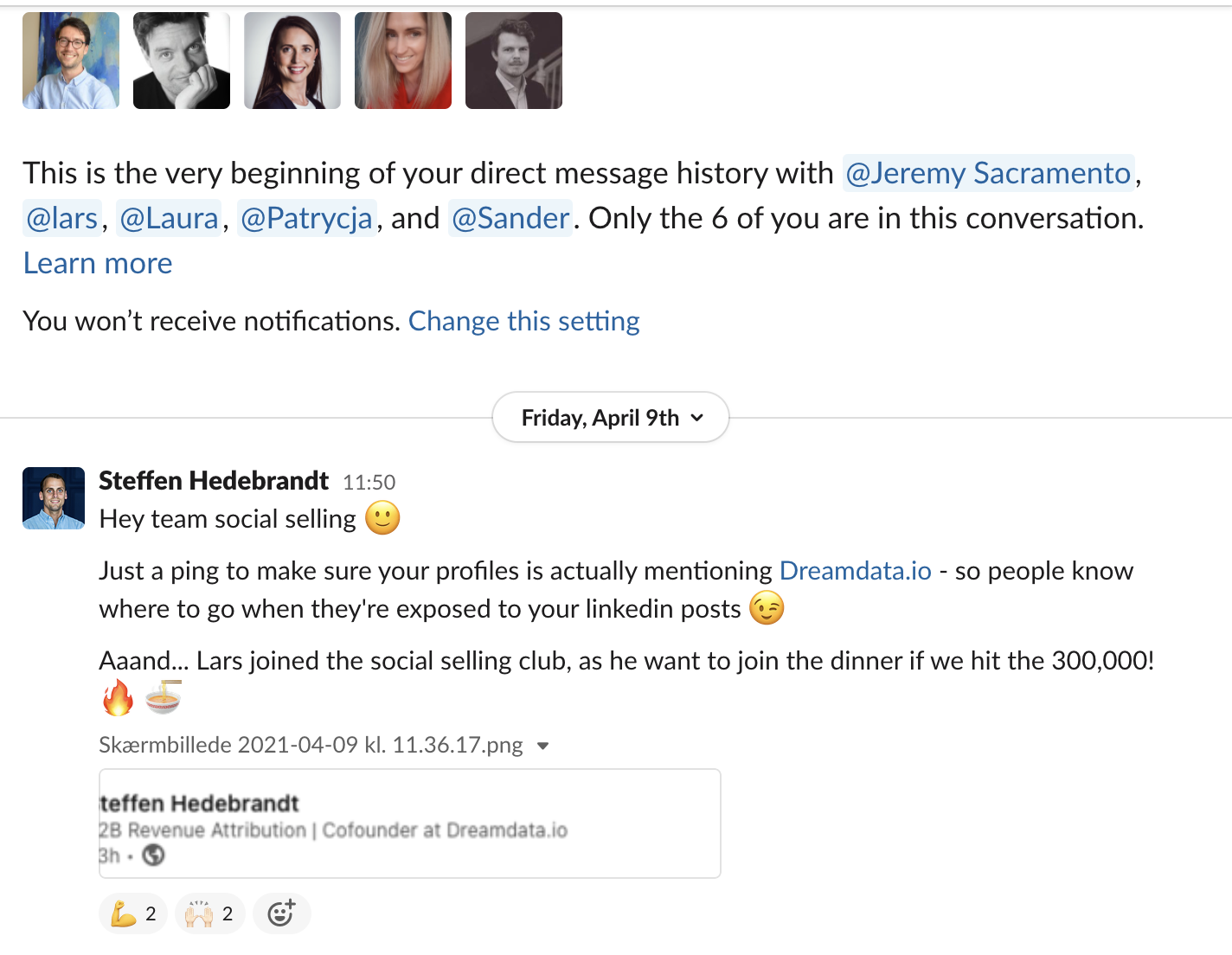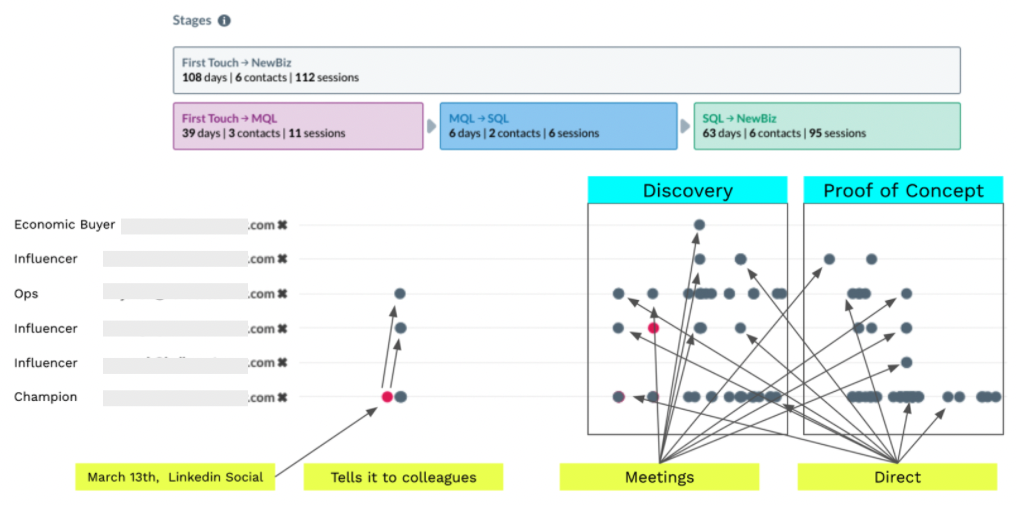Social selling: how we started and what we’ve learned
Snippet from Shield app.
Read any modern ‘inside sales’ playbook and you’ll likely find this oft-repeated mantra:
You should post on LinkedIn. You should social sell.
However, most companies never get really the ball rolling. More often than not, initial attempts fizzle out and end with a return to the usual way of working.
At Dreamdata, we put the idea to test. We took to LinkedIn and we started social selling. And demand is now accelerating because of it.
Now, we can't claim to have found the perfect recipe. Neither can we claim our process will work for you. The only thing we can do is tell you our Linkedin social selling story and what we’ve learned.
So here goes.
Laura convinced us
Being exposed to the same advice, we at Dreamdata had also been down the “we should give social selling on LinkedIn a try” discussion. And we too, absorbed in the many projects in front of us, hadn’t gotten round to setting it in motion. We were just doing the occasional post. Nothing deliberate or determined.
The game-changer came when our awesome AE, Laura Erdem, struck Linkedin gold with a post about the customer journey.
It landed on a regular weekday. There was nothing out of the ordinary in our plan. Nothing except for Laura's casual post, that is. Suddenly, the likes started rolling in. And before long, Linkedin influencers, like the inspirational Chris Walker, dropped some comments and made the likes roll even more.
At first, following a post by a data dreamer going somewhat viral was little more than a dopamine-rush. But it quickly became more than a thrill. Results of greater business relevance quickly emerged. These included:
The post had been seen close to 40,000 times on Linkedin.
The Dreamdata website had its best-ever day in terms of visitors.
And most importantly, we produced the most Marketing Qualified Leads (ICP’s doing valuable conversions) ever.
Those are real business results. Results powerful enough not to be ignored.
Catch Laura’s post below.
Let’s try and we’ll go for dinner if it works
Having seen with our own eyes the business impact a successful LinkedIn post could have, we decided to give it further attention. So... We put a team dinner on the line.
The approach would be simple. Everybody was to start posting quality content on Linkedin, frequently. If we hit 300,000 views of our combined posts in Q2, we’d be treated to a team dinner at the end of the quarter.
There was no detailed plan on how to get there.
Ultimately, our team managed to hit +520,000 views of our posts in Q2! 🎉📈
Here’s what we found worked for us:
Focus on QUALITY storytelling.
Write it like you would tell a friend.
Post multiple times per week.
Don't overthink it. Posts should take less than 15 minutes to make.
Find the content type you like. e.g. Laura is (also) good on video. I prefer text. Sam, Sander and Jeremy make memes etc.
Not all posts should be about your product.
Motivate each other.
Rarely include links to posts outside of Linkedin.
A little bit more about LinkedIn memes (updated Nov 2022)
Actually, our memes deserve a dedicated mention as they have proved a cornerstone of our social selling. Across our team they have generated over 2 million impressions. Learn more about LinkedIn memes here.
Check out some of our best posts:
Sander Luckow https://www.linkedin.com/feed/update/urn:li:activity:6812712115627966464
Samuel Malpiedi
https://www.linkedin.com/posts/samuel-malpiedi-2a889291_b2bsales-b2bmarketing-attribution-activity-6830464164100677632-mN0ELaura Erdem
https://www.linkedin.com/feed/update/urn:li:activity:6831125715220520960/
The results
So we had a glimpse of what to expect results-wise from Laura's single post. But beyond that, we didn't know what to expect from the wider team effort at the end of the quarter.
Boy have we been surprised - positively.
Let me list some of the results and benefits that we’ve seen:
B2B is a multi-touch game. The modern buyer journey is more hands off than ever before. Accounts rely on a huge number of touches from across sources to gain trust in a product and eventually buy.
Our team’s 520,000 post views, have gone a long way in demonstrating that our product is pretty damn smart, which by extension, increases trust in our brand.Here’s an example of a Dreamdata customer averaging +37 website sessions before a deal is signed. Talk about multi-touch! Actually we’ll get to that
This large “increase in post views” most likely drives a lot of word of mouth as well, as Dreamdata becomes the brand when people mention “B2B Attribution” or “Revenue Attribution”.
Every successful post drives up website traffic on the day it happens, feeding the retargeting audience as well as converting to leads, MQLs and free signups.
MQLs with where can attribute Linkedin as 1st touch has 3x’ed.
MQLs with Direct as 1st touch have 2x’ed. Now, on this one, there’s no direct attribution to be done, but everything else being equal, we think the awareness gained is driving this increase in direct MQLs.
An unexpected, but very important result, has been the activation of the accounts that we’ve tried to address outbound without any luck. They are now coming back having read several posts and gained trust in our abilities.
What does that make the account? Outbound? Inbound? Allbound?
Lastly, all of us are starting to receive invites to podcasts, video shows and articles wanting our opinion on all sorts of topics related to what we’ve been posting.
I recently discussed our social selling story in this podcast with Paris Childress.
How are we able to attribute this?
Now, this is where we take it up a notch.
So thanks to our platform we can plot the touches onto the customer journey map and link the activity directly to pipeline and revenue generation.
This is how the magic happens.
The tracking script sitting on our site logs every user event happening on our site. Initially, all we’ll have are events linked to an anonymous ID. Once the user identifies herself through a form submission - books a demo call, downloads an e-book, signs up to Free etc. - we can start enriching the profile and eventually the account.
Yes, Dreamdata’s attribution is account-based.
Our platform then models the data to enable us to attribute activities to revenue, and map the account-based customer journeys. Giving us solid proof of what are actually the touches on our deals.
And crucially, on whether or not our Linkedin social selling post had any role in the customer journey.
You might also be interested in this post on how Dreamdata helps Sales teams close more deals.
Just before ending this post, let me throw in a caveat. It’s probably not for all industries to play this game. I might be wrong obviously, but a reason this might be working particularly well for Dreamdata is that we’re targeting B2B marketers who spend a lot of time daily on Linkedin.
If you’re in an industry that’s not naturally spending a lot of time on Linkedin it might not play out as effectively.
Why not see what you can learn from your customer journeys?








